BOOK I
MODERN INVENTIONS AND DISCOVERIES
ACHIEVEMENTS OF THE WORLD'S MOST INGENIOUS MINDS--WONDROUS ADVANCE IN EVERY DEPARTMENT OF UNIVERSAL KNOWLEDGE
SHIPS OF THE AIR
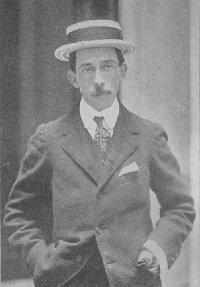 | | SANTOS-DUMONT | | Inventor of the Airship |
The name of M. Alberto Santos-Dumont, the son of a Brazilliam coffee planter, will go down in history as that of the man who solved the riddle that for centuries perplexed scientists—that of successfully navigating the skies. In the past ten years more advance has been made in the solution of the problem of aerial navigation than in the whole century since the Montgolfier brothers invented the balloon. With the experiments of Santos-Dumont, in which he showed the dirigibility of his airship, it is believed that the problem has passed the guesswork stage and now needs ony further development along lines laid down by him to establish the commercial value of this great invention.
For years students of aeronautics studied kite flying, aeroplanes, balloons, with wings and ballons with propellers. Some few inventors were able to make flights of short distances by means of a series of planes which allowed them to soar after the fashion of birds. Prominent among these inventors was Lilienthal, who lost his life in one of his experiments. The true story of the airship up to the present time lies in that of Alberto Santos-Dumont, although somehwat successful flights have been made over London and New York by Leo Stevens in a dirigible balloon. Santos-Dumont was born in Brazil in 1873, and as a very young man became interested in aerial navigation. His first experiments were with spherical balloons, but he soon abandoned these for those of a cylindrical or cigar-shape, and his triumphant success was gained with the fifth one which he constructed. He won his first large prize for successfully directing a ship about the Eiffel tower, in Paris, from St. Cloud and return. The balloon was 111 feet long by 20 feet in diameter. Paris has always been the center of activity in aerial navigation, and a large club of aeronauts has helped to promote interest in the conquest of the air. One of the members, M. Deutsch, in order to stimulate invention, offered a prize of 100,000 francs ($20,000) for a successful balloon trip over the above-mentioned course in 40 minutes.
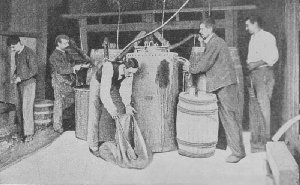 | | SANTOS DUMONT'S WORKSHOP |
The daring navigator rounded the great structure at a distance of not more than 300 feet from it, and at a height of some 500 feet above the ground. Since this achievement the aeronaut has constructed other machines. with which he has had only moderate success. One ship lodged on the chimney tops of Paris, while another fell into the sea in the Bay of Monaca. Nevertheless, so great has been his success that his work so far eclipses all that of other experimenters.
A BALLOON 419 FEET LONG.
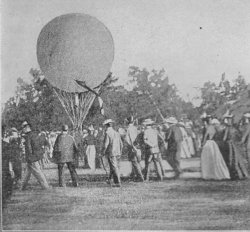 | SANTOS DUMONT'S
FIRST BALLOON (SPHERICAL) |
Count Von Zeppelin, of Berlin, is also an inventor of some note, and has within the past two years constructed several airships, among which was one of gigantic dimensions. This balloon, which was constructed near Berlin, has a length of 419 feet, while that of Tissandier was only 91 feet in length, that of Dupuy de Lome, 118 feet, that of Haenlein, 132 feet, that of Giffard 144 feet, that of Schwarz, 154 feet, and that of Renard 165 feet. It will be seen that the airship of Count Von Zeppelin is, therefore, nearly two and a half times as large as any previously constructed.
A cylinder, 37 feet in diameter, forms the main body of the balloon, the ends being slightly elongated ogives in shape. The framework of this airship was made of aluminum and consists of 26 polygons of 24 sides each, placed 26 feet from each other, and held in position, perpendicular to the long axis of the balloon, by cross strips of aluminum. Each polygon is strengthened by a network of aluminum wire, which extends from a small central circle, in all directions, to the inner side of the polygon, just as spokes of a bicycle wheel extend from the hub to the rim.
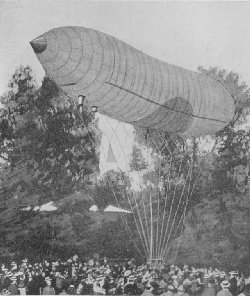 | | "SANTOS-DUMONT'S NO. 1" |
Seven separate compartments are thus formed, and inside of each of these compartments, as well as over the outside of the entire framework, is a net of strong but light-weight hemp cord. Into each of these compartments, inside the nets of aluminum wire and hempen cord, is placed a balloon, which is in no wise connected with any one of its fellows. Each of these seventeen balloons is filled separately, and if by any accident any of them burst or leak, the carrying power and utility of the balloon as a whole are not endangered or sacrificed.
Under the balloon and attached firmly to it by strong aluminum bars are two gondolas, also of aluminum. These gondolas are each 21 feet long, five feet wide, and three feet deep, and have under each of them large spiral springs, which prevent jarring the entire machine when landing after an ascension. The gondolas are connected by a bridge one foot wide, which is also firmly bound to the balloon by means of aluminum bars and ropes.
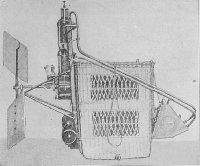 | By Courtesy of the "Scientific American"
BASKET OF "SANTOS DUMONT NO.1"
Showing Propeller and Motor |
In each gondola is a motor of 15 horsepower. Benzine is used as fuel, as, despite its great inflammability and the danger from fire which its use engenders, it is found to be the most practicable. Connected with the motors are four large aluminum screws, similar to those of steamships, which serve to propel the balloon through the air. Two of these are placed at the forward end, at a point where the straight sides of the cylinder begin converge toward the ogival and bow of the airship, and the other two are at a corre point at the rear.
The balloon, or airship, is steered by a sort of rudder consisting of a framework covered with balloon cloth, and which can be moved to the right or left, or up and down. One of these is at either end of the balloon, and changes its course in the same -way and on the same principle as does the rudder of a ship. 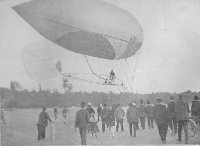 | | SANTOS DUMONTS NO. 9 |
A weight which slides along. a rope is attached to the underside of the gondolas and the bridge which connects them. If this weight be placed under the rear gondola the rear half of the balloon, being heavier than the fore, remains lower in the air, and the propelling screws being set in motion, the balloon moves forward, and, of course, rises. If the weight be moved forward the angle is changed until, when the weight reaches the center, the balloon moves in a straight line, and then, as the weight advances more and more the front becomes heavier than the back and the balloon descends. A rope reaching from the bow to the stern of the balloon, and hanging slack under it, combines with the weight in accomplishing the directing of
airship.
The ship of Santos-Dumont, while not quite as long as that of Count Von Zeppelin, is constructed with as much care and at nearly the same material.
THE LANGLEY FLYING MACHINE.
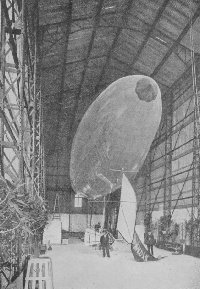 | By courtesy of the "Scientific American"
THE INTERIOR OF THE AERODOME
Showing its Construction,
the inflated balloon, and the
pennant with mystic letters |
A balloon styled the "Langley flying machine" was constructed in the summer of 1903 under the supervision of experts in the employ of the United States government, who pronounced the basic theory on which it was planned infallible. The cost of designing and making it, together with the expense attending several experimental trips under disastrous conditions, was $72,000. The final test, September 12, 1903, resulted in a complete collapse of the airship, on account of a lack of rigidity in its frame,
and by reason of weakness in its propelling apparatus, in which strength had been sacrificed for the sake of lightness.
THIRD SERIOUS DISASTER
The find wrecking was the third and most serious disaster which befell the inventor. Three propellers had been previously broken during experiments, and other parts were disabled while the secret tests in the Smithsonian Institute were being conducted.
GATHMANN'S DESIGN.
Louis Gathmann, who invented the gun bearing his name, is planning a flying machine weighing 15,000 pounds, constructed of nickel steel, with two 500-horse-power engines. The lifting power of this machine is centered in a heavy, revolving horizontal fan, the blades being shaped like a Maltese cross. The cost is estimated at $136,000.
AUTOMOBILES AND THEIR DEVELOPMENT
Listings for Book 1
Table of Contents
Return to Main Page
© 1998, 2002 by Lynn Waterman
|






